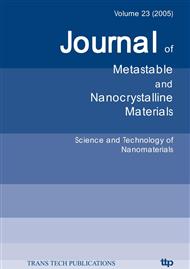p.35
p.39
p.43
p.47
p.51
p.55
p.59
p.63
p.67
Linking Additive Structures to Nanoparticle Properties
Abstract:
The effects of a series of polyphosphonate and poly-carboxylate additives have been investigated in the crystallization of various inorganic salts. Systematic variation of the additive structure has been used to provide insight into the dominant factors in additive-crystal interactions. The results obtained for barium sulfate and hematite (α-Fe2O3) show that the morphological effects do not necessarily follow the trend one might expect on the basis of the structural features of the additives. Molecular modeling, coupled with in-situ AFM imaging is being used to develop an approach that will allow more informed systematic design of crystal growth modifiers.
Info:
Periodical:
Pages:
51-54
Citation:
Online since:
January 2005
Keywords:
Price:
Сopyright:
© 2005 Trans Tech Publications Ltd. All Rights Reserved
Share:
Citation:


